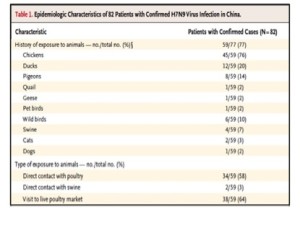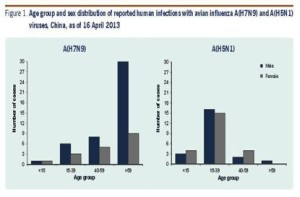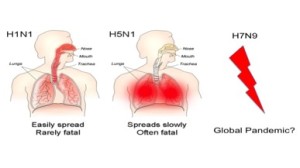“Outbreak spreading from mainland China which include H5N1 (1997) and SARS (2003), have put the territory on health alert.”
“We will heighten our vigilance and continue to maintain stringent port health measures in connection with this development,” the Centre for Health Protection in Hong Kong stated in a previous press release.
Now comes a new ongoing mystery…the clock is ticking, and the world wants answers. If we were imagining how a terrible pandemic (world-wide outbreak) would unfold, this could certainly serve as an excellent script. A forecaster might reasonably conclude that H7N9 is likely to follow a H5N1-like path, causing only occasional but frightening cases in people, and never spawning a human pandemic. However, there are reasons to believe the numbers of human cases, especially milder ones, are wildly wrong, directing our eyes to that dicey H1N1-like path. Let’s hope it will not be fatal and easily spread. We should understand this phenomenon before we conclude our story. I will try my best to explain in layman terms and will not touch on molecular level of the disease instead more on the disease pattern and distribution.
H7N9 is a subtype of the influenza virus that is sometimes found in birds, that does not normally infect humans. Influenzas are named according to the specific nature of two proteins found on the virus itself — the H stands for hemagglutinin and the N for neuraminidase. These proteins play various roles in the flu-infection process, including latching onto receptors on the outside of the cells of animals to transmit the virus into their bodies. Those receptors can vary widely from one species to another, which is why most types of influenza viruses spreading now around the world are harmless to human beings and mainly effects animals and birds.
The H7N9 forms of flu have never previously managed to infect human beings, or any mammals. It is a class of the virus found exclusively in birds. It is therefore extremely worrying to find people killed and barely surviving due to H7N9 infection.
If you still remember, it was a devastating event when China announced its outbreak on March 2013. The H7N9 outbreak in China offered a long list of puzzles, many of which are the key to understanding whether this Chinese epidemic will erupt into a global pandemic or not.
In order to better understand this phenomenon, let us view some statistics as depicted in the tables and graphs. H5N1 avian flu, which has spread among birds and humans since the 1990s, has an opposite case distribution as compared to H7N9. Most of the 371 deaths caused by H5N1 since 2003 have been in children. Why? Some reasonable scientist stated that youngsters play around with chickens, ducks and other poultry that may be infected with the virus in their own family farm. Well I ask myself, why not the elderly? In a way, we should be thankful that the virus did not react on the elderly or we might be seeing more fatalities.
Even normal or seasonal flu that circulates every year will affect and kill people in a different pattern, distribution and are usually skewed towards over-70-year old adults and roughly equally by gender. However the gender distribution is slightly different in the case of H7N9 (more towards male) and it affects adults and elderly (like other seasonal flu). This can be devastating as H7N9 is fatal, and if it affects the elderly we will inevitably see more deaths in our health care centers.
We can also interpret these facts in two different ways. Firstly, the distribution towards older men may offer a clue to which animal or bird species is the host of the virus, from which the men are acquiring their infection (if not from other people) but direct contact, in other words directly from the source. Secondly, the older men may be especially vulnerable for some reason. As WHO put it: “It may be due to an imbalance in exposure of the elderly to H7N9, or physiological factors related to aging, such as decreased immune function.”
Analysis of the first 82 cases in China offers some vital clues, at least for the 77 individuals the Chinese CDC was able to interview before they passed away. A handful of the individuals had occupational-related contact with animals, as poultry workers, butchers or chefs. The remainder had some contact with chickens or chicken meat, and a few other avian species. The numbers point to chickens (see Table 1). Why male and not female? In my opinion, women prepare meals in China, pluck the chicken feathers and handle food at home and if household chicken exposure is the key to infection, the gender distribution of H7N9 cases makes little sense since more male are affected than female (Figure 1). So I strongly feel, livestock, domestic animals, live birds play a vital role in MOT (mode of transmission) during the contact of these animals in the farm or wet market itself and not dead or cooked meat that are brought home.
Since we now understand the disease dynamic, let’s now proceed to the real game. Will we actually face a great pandemic with H7N9?
Due to continuous pressure from WHO, for the first time ever, a comprehensive genetic analysis of the H7N9 bird flu virus was carried out by scientists in China.
It was then followed by a recent study published in the Lancet, researchers have confirmed that the A type H7N9 bird flu virus, which began in February 2013, was transmitted from chickens at a wet poultry market to humans.
The diversity among the specimens collected suggests that the H7N9 virus might have evolved into two different lineages. This is troubling news for all scientists and WHO. These are some of the exact words by the scientist;
“The H and N genes might originate from duck avian influenza viruses, which might have obtained the viral genes from migratory birds a year previously, whereas the internal genes might come from chicken avian influenza viruses. In particular, this novel H7N9 virus has diversified into different lineages since its emergence several months ago.”
I think the last statement from those scientists gave us an insight into how capable H7N9 can evolve, and that definitely answers our pandemic question; will we face a pandemic?
Influenza viruses constantly change and it is possible that this virus could easily and sustainably spread between people, triggering a pandemic.
It is in our gut fear, as H7N9 can possibly bring worldwide transmission of a dangerous new form of flu that could spread unchecked throughout humanity, testing global solidarity, vaccine production, hospital systems and humanity’s most basic family and community instincts. Therefore, it is imperative that extensive global surveillance is carried out to ensure that domestic-poultry-to-person transmission is carefully watched.
Let’s start with proper surveillance today.
Dr. Dhesi BR is the founder of The Malaysian Medical Gazette and also a future public health specialist. He is currently pursuing a PhD in preventive medicine and public health. Learn more about him at The Team page.
References:
- Public Health Systems and Emerging Infections by Jonathan R Davis, Joshua Lederberg (ed.) – National Academies Press ,2000
- Epidemiology Insights by Maria de Lourdes Ribeiro de Souza da Cunha – InTech , 2012.
- BBC “H7N9 in China” – Global view
- Epidemiology for the Uninitiated by David Coggon, David Barker, Geoffrey Rose – BMJ Books , 2003
- WHO (International Disease)
- CDC Atlanta on Influenza Disease
[This article belongs to The Malaysian Medical Gazette. Any republication (online or offline) without written permission from The Malaysian Medical Gazette is prohibited.]




